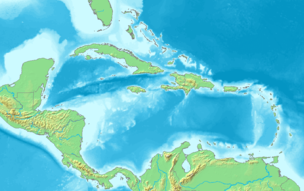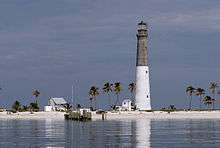Loggerhead Key
Loggerhead Key is an uninhabited sub-tropical island within the Dry Tortugas group of islands inside the Gulf of Mexico.[3] At approximately 49 acres (19.8 hectares) in size, it is the largest island of the Dry Tortugas.[3][4][5] Despite being uninhabited, the island receives visitors, such as day visitors and campers.[3] The island only has a few built structures, including the Dry Tortugas Light and a lightkeeper's house that was constructed in the 1920s.[3] The island has drinking water derived using desalination technology and solar power.[3] The Carnegie Marine Biological Laboratory operated on Loggerhead Key from 1904 to 1939.
.jpg) An aerial view of Loggerhead Key, Dry Tortugas | |
 Loggerhead Key  Loggerhead Key | |
| Geography | |
|---|---|
| Location | Dry Tortugas at the end of Florida Keys, United States |
| Coordinates | 24°37′57″N 82°55′14″W[1] |
| Archipelago | Florida Keys |
| Adjacent bodies of water | Gulf of Mexico |
| Total islands | 7 |
| Major islands | Garden Key |
| Area | 10,000,000 acres (4,000,000 ha) |
| Highest elevation | 10 ft (3 m)[2] |
| Administration | |
United States | |
| State | Florida |
| County | Monroe County |
| Census County Division | Lower Keys |
| Demographics | |
| Population |
|
| Additional information | |
| Time zone | |
| • Summer (DST) | |

.jpg)
Etymology
Loggerhead Key is named after the loggerhead sea turtle, an endangered marine reptile and species of sea turtle with a cosmopolitan distribution throughout the world.[3]
Coral reefs
The Little Africa coral reef is located at Loggerhead Key.[4] The reef is home to various species of tropical fish, spiny lobster and several juvenile game fish.[4] Coral types include "various species of stony and gorgonian coral".[4]
Flora and fauna
The flora of Loggerhead Key includes mangrove, coconut trees, geiger trees, morning glory, sea lavender and cactus.[3] In the 1840s, the island was covered with white buttonwood trees, which were burned or cut down by island inhabitants.[6] Bay cedar existed on the island in the early 1900s.[6]
Fauna of Loggerhead Key includes sea turtles, which are monitored by park rangers with the Dry Tortugas National Park to document nesting and hatching rates.[7] The loggerhead sea turtle is also present on the island.[8] In August 2016, a National Park marine biologist stated that 113 loggerhead turtle nests existed on the island at that time.[8] This was the highest recorded nest rate compared previous years.[8]
The island also has brown pelicans.[7]
Former rhesus macaque habitat
In 1972, hundreds of rhesus macaque monkeys were brought from India to Loggerhead Key by Charles River Laboratories.[9][10] This was done to provide the monkeys a place to breed, to supply the animals for medical research laboratory experiments.[9][10] Around 1,322 of the monkeys existed on the island between 1987–1990.[10]
Dry Tortugas Light

The Dry Tortugas Light is a lighthouse located on Loggerhead Key.[4][11] It began operations in 1858 and was decommissioned in 2014.[7][12]
Carnegie Marine Biological Laboratory
The Carnegie Marine Biological Laboratory, also referred to as the Tortugas Laboratory, was a marine biology laboratory and research facility constructed on the northern end of Loggerhead Key that operated from 1904 to 1939.[4][13][6] It was constructed and operated by the Carnegie Institution of Washington.[4][14][15] The Carnegie Marine Biological Laboratory performed some of the first research on Western hemisphere mangroves and coral reefs, marine life at the Loggerhead Key coral reefs, other marine life, and also performed underwater color and black-and-white photography there.[14][15] Due to safety concerns regarding the hurricane season, research only occurred in the late spring and summer months.[6]
References
- "Loggerhead Key". Geographic Names Information System. United States Geological Survey. October 19, 1979. Retrieved October 18, 2017.
- "Loggerhead Key High Point". Peakbagger.com.
- Block, Melissa (October 26, 2016). "Making Art Off The Grid: A Monthlong Residency At A Remote National Park". WLRN. Retrieved September 7, 2017.
- "Explore Loggerhead Key". Dry Tortugas National Park (U.S. National Park Service). August 28, 2015. Retrieved September 7, 2017.
- Oswald, M.J.; Pankratz, D. (2017). Your Guide to the National Parks of the East: Acadia, Cuyahoga Valley, Shenandoah, Mammoth Cave, Great Smoky Mountains, Congaree, Biscayne, Everglades, and Dry Tortugas. Stone Road Press. p. pt151. ISBN 978-1-62128-069-9. Retrieved September 7, 2017.
- "Loggerhead Key Restoration". Dry Tortugas National Park (U.S. National Park Service). July 29, 2015. Retrieved September 7, 2017.
- Zach, Elizabeth (August 28, 2016). "West of Key West, an Under-the-Radar National Park". The New York Times. Retrieved September 7, 2017.
- Wadlow, Kevin (August 28, 2016). "It's a baby boom for sea turtles as nests pop up all over". miamiherald. Retrieved September 7, 2017.
- Philpott, D. (2006). Florida: The Keys. LANDMARK VISITORS GUIDE FLORIDA KEYS. Hunter Pub Incorporated. p. 68. ISBN 978-1-84306-210-3. Retrieved September 7, 2017.
- Simberloff, D.; Schmitz, D.C.; Brown, T.C. (1997). Strangers in Paradise: Impact And Management Of Nonindigenous Species In Florida. Island Press. p. 163. ISBN 978-1-59726-331-3. Retrieved September 7, 2017.
- Griffes, P.L. (2004). 2004 Atlantic Boating Almanac: Gulf of Mexico. ProStar Publications, Incorporated. p. 204. ISBN 978-1-57785-512-5. Retrieved September 7, 2017.
- Miller, M.; Propert, M. (2012). Miami & the Keys. National Geographic Traveler Miami & the Keys. National Geographic. p. 234. ISBN 978-1-4262-0953-6. Retrieved September 7, 2017.
- "Your dream job? 1 month on a deserted island as artist in residence". Miami Herald. June 19, 2016. Retrieved September 7, 2017.
- Taylor, T.W. (2001). The Florida Lighthouse Trail. Pineapple Press. pp. 98–100. ISBN 978-1-56164-203-8. Retrieved September 7, 2017.
- Harris, A.G.; Tuttle, E.; Tuttle, S.D. (2004). Geology of National Parks. Kendall/Hunt Publishing Company. p. 280. ISBN 978-0-7872-9970-5. Retrieved September 7, 2017.
External links

- Loggerhead Key. National Park Service.
![]()